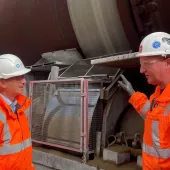Tarmac low-carbon concrete trialled on flood-defence scheme
BAM, Environment Agency and Tarmac trial ultra-low-carbon mixes on Hexham Flood Alleviation Scheme
IN a UK first, BAM, the Environment Agency and Tarmac have successfully trialled the use of two low-carbon concrete mixes in permanent works on the Hexham Flood Alleviation Scheme.
A duo of ultra-low-carbon concretes, developed by Tarmac to new specifications and compressive strength class C32/40, now form the base and walls of a new flood-defence structure designed to protect the town and mitigate against flood damage.
The trial has been delivered and funded by the Environment Agency’s Collaborative Delivery Framework Hub A, a collaboration between the Environment Agency, Arup, and BAM, as part of a wider project to deliver flood-defence schemes across north-east England.
The culmination of an 18-month project, from planning to delivery, it is the first time that low-carbon concretes developed by Tarmac have been used in permanent works.
One of the new concretes in use by Tarmac is a Portland limestone ternary cement C VI, brought in by a new cement standard, BS EN 197-5. This concrete has three cementitious components – cement clinker, ground granulated blast-furnace slag (ggbs) and up to 20% limestone filler to replace some of the ggbs.
Compared with a standard CEM I, it offers a 64% reduction to 119kg/m3 CO2e per cubic metre of concrete delivered to site. A new version of BS8500, the UK concrete standard, is expected later in 2023, introducing these ternary cements.

The second new concrete is an alkali-activated cementitious material (AACM) with more than 95% ggbs as the cementitious component. This mix offers a 70% reduction to 100kg/m3 CO2e compared with a standard CEM I. Standards are still being developed for AACM products.
Both mixes – which have been manufactured at Tarmac ready-mixed concrete plants in Thrislington, Co. Durham, and Teesside – have been tested for fresh and hardened properties, as well as a number of longer-term durability tests.
With sustainability a primary consideration, the carbon footprint of the new concrete has been calculated using the BSI PAS2080 specification – a method for assessing the life-cycle greenhouse gas (GHG) emissions of concrete.
In the UK, cement, a critical component of concrete, produces an average of 1.5% of emissions, with innovation and investment in efficient plant and fuel-switching to waste biomass and road tyres making an important contribution to lowering emissions.
Concrete footprints are further lowered by replacing some of the cement with secondary cementitious materials such as fly ash, ggbs and now limestone fillers.
If successful, trials of new ultra-low-carbon concrete alternatives will allow future Environment Agency flood defences to be built more sustainably, with lower embodied carbon. They will also support the delivery of new sustainable concrete products to the wider construction industry.
Leila Huntington, Environment Agency operations manager, said: ‘The Environment Agency is committed to helping the nation be more resilient to flooding, coastal change, drought and climate change. We all have a role to play in tackling the climate emergency, which is why the Environment Agency has committed to reaching Net Zero by 2030. To achieve this, we have to adapt, try innovative approaches and ensure that climate and sustainability are at the heart of what we do.

‘The trial of low-carbon concrete in Hexham is a fantastic example of how we can work with our partners to continue to build flood defences to better protect communities from flooding, whilst also focusing on sustainability, the environment and reducing our carbon emissions.’
Ruth Young, area carbon and sustainability lead for BAM, commented: ‘As the Environment Agency’s construction partner in the North East, we are carefully considering how we can limit the environmental impact of the flood-defence work we deliver within the Collaborative Delivery Framework, without compromising the strength and resilience of these structures.
‘We identified Tarmac’s new low-carbon concrete mixes as innovative products which have the potential to reduce our overall carbon impact across the framework.
‘We are working closely with the Environment Agency, Arup and Tarmac to ensure the materials can be approved for use and look forward to seeing these being used on more civil engineering schemes in the future.’
Robert Gossling, head of commercial engineering solutions at Tarmac, said: ‘This flood-defence project in Hexham highlights the clear sustainability benefits which can be achieved when clients and contractors work in partnership, in this case engaging to help understand the benefits and reduce the concrete carbon footprint of the Environment Agency. The testing comparisons will help build confidence in these new products.
‘Against the backdrop of a climate emergency, the use of these mixes marks another important step for the UK concrete and cement industry along its path to net zero. We’re committed to demonstrating innovation in low-carbon solutions, and we hope that the success of this trial will help accelerate adoption of this and other types of new, sustainable concretes – delivering long-term benefits for the industry.’
The flood-defence scheme at Hexham is expected to be completed this summer, reducing the flood risk posed by the river Tyne with approximately 600m of new flood walls and grass embankments. Approximately 90 properties were flooded by the river at the Bridge End and Tyne Mills Industrial Estates on 5 December 2015, during Storm Desmond.
Tarmac say the site will be monitored via a rigorous testing regime to demonstrate the long-term durability and suitability of the concrete mixes, with data collected used to provide insights into the future use of low-carbon solutions.







